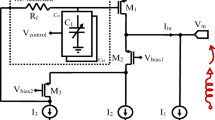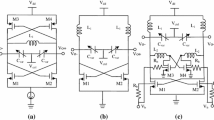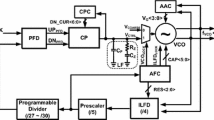Abstract
A low-power, inductorless, UWB CMOS voltage controlled oscillator is designed in 0.18 μm CMOS technology targeting to a UWBFM transmitter application. The VCO is a Double-Cross-Coupled Multivibrator and generates output frequencies ranging from 1.55 GHz to 2.4 GHz. A low-power frequency doubler based on a Gilbert cell, which operates in weak inversion, doubles the VCO tuning range from 3.1 GHz to 4.8 GHz. The proportionality between the oscillation frequency and the bias current is avoided in this case for the entire achieved tuning range resulting in a low-power design. The selected architecture provides high suppression, over 45 dB, for the 1st and 3rd harmonics, while enabling high-frequency operation and conversion gain due to the unbalanced structure and the single-ended output. The proposed VCO draws 4 mA from a 1.8 V supply, it has a phase noise of −76.7 dBc/Hz at 1 MHz offset from the center frequency, while it exhibits a very high ratio of tuning range (43%) over power consumption equal to 7.76 dB.
Similar content being viewed by others
References
T. Barret, History of Ultra Wideband (UWB) radar & communications: pioneers and innovators, in Proc. Progress in Electromagnetics Symposium, July 2000, Cambridge, MA, USA (2000), pp. 1–42
A. Buonomo, A. Sciavo, Analysis of emitter (source)-coupled multivibrators. IEEE Trans. Circuits Syst. I 53, 1193–1202 (2006)
M. Deen, R. Murji, A. Fakhr, N. Jafferalli, W. Ngan, Low power CMOS integrated circuits for radio frequency applications. IEEE Proc. Circuits Devices Syst. 152, 509–522 (2005)
M.A. Do, R.Y. Zhao, K.S. Teo, J.G. Ma, New wideband/dualband CMOS LC voltage-controlled oscillator. IEEE Proc. Circuits Devices Syst. 150, 453–459 (2003)
I. Finvers, I.M. Filanovsky, Analysis of source-coupled CMOS multivibrator. IEEE Trans. Circuits Syst. 35, 1182–1185 (1998)
A. Georgiadis, M. Detratti, A linear, low-power, wideband CMOS VCO for FM-UWB applications. Microw. Opt. Technol. Lett. 50, 1955–1958 (2008)
J.F.M. Gerrits, M.H.L. Kouvenhoven, P.R. van der Meer, J.R. Farserotu, J.R. Long, Principles and limitations of ultra-wideband FM communications systems. EURASIP J. Appl. Signal Process. 3, 382–396 (2005)
R. Hogervorst, Design of low-voltage low-power CMOS operational amplifier cells. PhD Thesis, TU Delft, 1996
A. Jerng, C. Sodini, The impact of device type and sizing on phase noise mechanisms. IEEE J. Solid-State Circuits 40, 360–369 (2005)
K. Kimura, Some circuit design techniques for bipolar and MOS pseudologarithmic rectifiers operable on low supply voltage. IEEE Trans. Circuits Syst. Fundam. Theory Appl. 39, 771–777 (1992)
K. Kimura, A bipolar four-quadrant analog quarter-square multiplier consisting of unbalanced emitter-coupled pairs and expansions of its input ranges. IEEE J. Solid-State Circuits 29, 46–55 (1994)
K. Kimura, H. Asazawa, Frequency mixer with a frequency doubler for integrated circuits. IEEE J. Solid-State Circuits 29, 1133–1137 (1994)
D. Leeson, A simple model of feedback oscillator noise spectrum. Proc. IEEE 54, 329–330 (1966)
R. Murji, M. Deen, Design issues of a low power wideband frequency doubler implementation in 0.18 μm CMOS. Analog Integr. Circuits Signal Process. 53, 53–62 (2007)
L.B. Oliveira, A. Allam, I.M. Filanovsky, J. Fernades, On phase noise in quadrature cross-coupled oscillators, in Proc. IEEE International Symposium on Circuits and Systems, May 2005, Kobe, Japan (2005), pp. 2635–2638
A. Popov, N. Tchamov, P. Jarske, New high speed double cross-coupled ICO/VCO, in Proc. IEEE International Conference on Electronics, Circuits and Systems, Oct. 1996, Rhodes, Greece (1996), pp. 243–246
B. Razavi, A study of phase noise in CMOS oscillators. IEEE J. Solid-State Circuits 31, 331–343 (1996)
B. Razavi, Design of Analog CMOS Integrated Circuits, 1st edn. (McGraw-Hill, New York, 2000)
B.J. Song, H. Kim, Y. Choi, W. Kim, A 50% power reduction scheme for CMOS relaxation oscillator, in Proc. First IEEE Asia Pacific Conference on ASICs, Aug. 1999, Seoul, South Korea (1999), pp. 154–157
N. Tchamov, A. Popov, P. Jarske, VCO with double cross-coupled high-speed and low-power multivibrator architecture, in Proc. IEEE International Symposium on Circuits and Systems, May 1996, Atlanta, USA (1996), pp. 45–48
N. Tchamov, A. Popov, P. Jarske, New low-power/high speed double-cross-coupled ICO/VCO, in Proc. IEEE MTT-S Symposium on Technologies for Wireless Applications Digest, Feb. 1997, Vancouver, BC, Canada (1997), pp. 157–158
T. Tong, Z. Wenhua, J. Mikkelsen, T. Larsen, A 0.18 μm CMOS low power ring VCO with 1 GHz tuning range for 3–5 GHz FM-UWB applications, in Proc. IEEE 10th International Conference on Communication Systems, Oct.–Nov. 2006, Singapore (2006), pp. 1–5
W. Tu, J. Yeh, H. Tsai, C. Wang, A 1.8 V 2.5–5.2 GHz CMOS dual input two stage ring VCO, in Proc. IEEE Asia-Pacific Conference on Advanced System Integrated Circuits, Aug. 2004, Fukuoka, Japan (2004), pp. 134–137
P. Vaananen, M. Metsanvirta, N. Tchamov, A 3.6 GHz double cross-coupled multivibrator VCO with 1.6 GHz tuning. IEEE Trans. Circuits Syst. II, Analog Digital Signal Process. 48, 79–802 (2001)
P. Vaananen, M. Metsanvirta, N. Tchamov, A 4.3 GHz VCO with 2 GHz tuning range and low phase noise. IEEE J. Solid-State Circuits 36, 142–146 (2001)
C.-C. Wei, H.-C. Chiu, W.-S. Feng, An ultra-wideband CMOS VCO with 3–5 GHz tuning range, in Proc. IEEE International Workshop on Radio-Frequency Integration Technology, Nov.–Dec. 2005, Singapore (2005), pp. 87–90
Y. Zheng, C. Saavedra, Compact CMOS VCO using a transistor for frequency control, in Proc. ANTEM/URSI International Symposium on Antenna Technology and Applied Electromagnetics, July 2006, Montreal, Canada (2006), pp. 115–118
Author information
Authors and Affiliations
Corresponding author
Rights and permissions
About this article
Cite this article
Tsitouras, A., Plessas, F. Ultra-Wideband, Low-Power, Inductorless, 3.1–4.8 GHz, CMOS VCO. Circuits Syst Signal Process 30, 263–285 (2011). https://doi.org/10.1007/s00034-010-9220-6
Received:
Revised:
Published:
Issue Date:
DOI: https://doi.org/10.1007/s00034-010-9220-6




